February 2009
The T-T-T-Tow Truck Tour
Southern Chile
AKA - La Tortuga reluctantly sits back and leaves the driving to...
During our last visit with you, we said good-by as we were preparing to cross the border from Argentina into Chile, deep in the heart of Patagonia. We hit the internet café in Los Antiguos (a good one), stocked up with what food we thought we could get away with (remember the B.B.s at the border!), and got fuel, as we’d been told it would be more expensive on the Chilean side (turned out to be untrue: slightly less in Chile Chico). The weather was absolutely lovely, with nary a cloud in the sky. A great day for a border crossing.
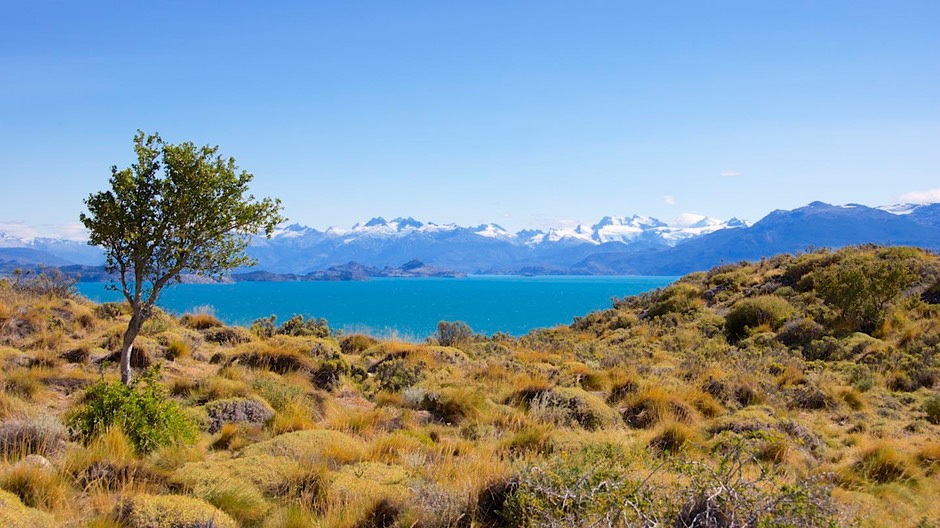
When you leave Los Antiguos, you go around a curve, cross the Río Jeinemeni, and come to an easy, casual border crossing into Chile. With our track record, we waited for the food inspector to rip us apart, but he was apparently just getting ready to go on break and not very interested in us, so on we sped. An easy time of it for a change; and since we calculated this would be our last entry into Chile, we were jazzed. We do know others have not been so lucky at this location. We also noticed that a big new crossing was under construction on the Chile side; things may be a lot different within a few months.
Geographical minutae: Los Antiguos sits along the southern bank of Lago Buenos Aires; after you cross the border and are on the Chilean side it becomes Lago General Carrera. Different strokes for different folks. Whatever you want to name it, it is a huge, stunningly beautiful lake, glacier-fed and a lovely milky blue in color, with mountains on all sides. Picture perfect. The road, which follows the cliffs and is about 800 feet above the lake, was as nasty and treacherous (and even scary at times) as advertised, but well worth the effort. A truly wicked road! But that’s what adventure’s all about, right?
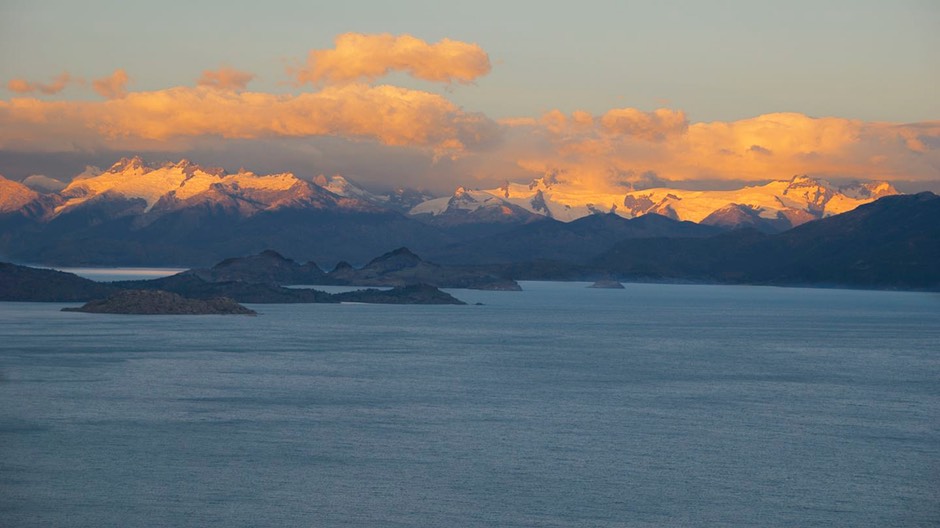
Our direction was west to the end of the lake, and then to pick up the Carretera Austral (Ruta 5), the beast of a road that travels the southern end of Chilean Patagonia, between and among the mountains, lakes and glaciers that make up the area. Its reputation is worse than that of La Cuarenta, its parallel sister road in western Argentina.
Still following the lake edge, we stopped that night on a promontory overlooking the lake, and awakened very early the next morning to see the mountains across the way bathed in the pink light of dawn. It was very cold, but I got out and took some lovely pictures before being driven back in by the cold and the strong winds.
We finally came to the end of the lake, and reached the Carretera. At this point, travelers have a choice. Turning left, Ruta 5 meanders to the south, through mountains and valleys and along rushing streams. It reputedly deteriorates as it goes. At times it is broken up by ferry rides across lakes. Chile is slowly pushing this road further and further south; reportedly eventually you will be able to drive (and take ferries) all the way to Torres del Paine, through the fjords. As of now it goes as far as Villa O’Higgins.
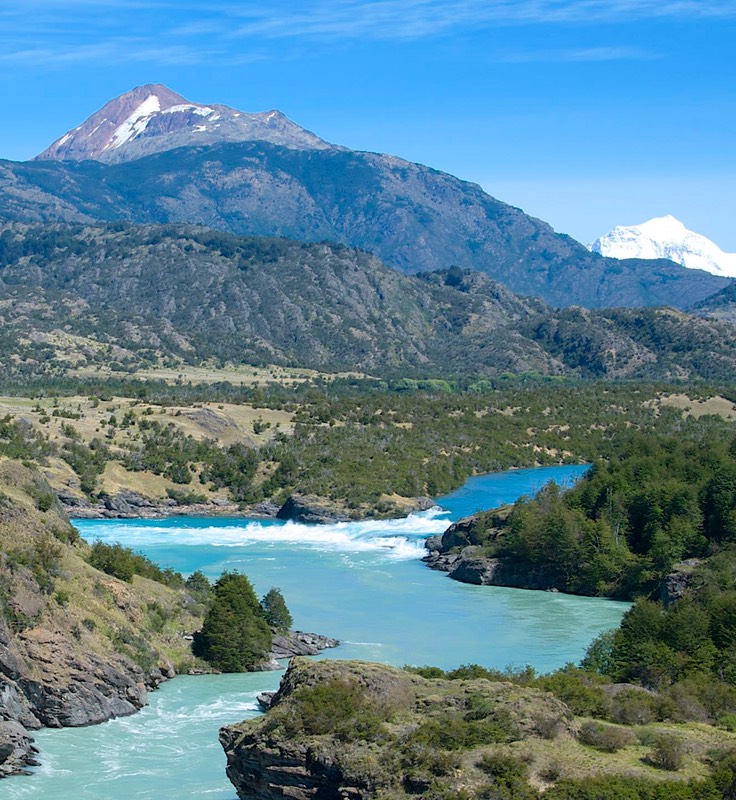
The other choice is to turn right, and begin moving north. If you go south first, you eventually have to turn around and retrace your steps as there is only the one road. We decided to see some of what was further south, and headed for Cochrane, which was supposed to be an interesting town with a large general store “where you can get anything.” This would take us down 50-odd kilometers. We could always decide to go the 200 kilometers further, all the way to Villa O’Higgins.
Our first treat was to cross the enormous and impressive Río Baker. Huge amounts of water were flowing south from it here, from where it originates out of the lake. Río Baker is Chile’s largest river, in terms of flow. Its color is an incredible blue, then lower down it is joined by another river which is milky white. It is quite a sight. The Río Baker is the source of a major, major bruhaha these days. No surprise. All that water…hmmm: think of all the electricity we could generate. Where have we heard all this before, so many times! Protest marches, signs saying “Patagonia sin represas,” appeals to the government, the usual shouting matches; so far no dams (represas) have been built. But we wouldn’t recommend you hold your breath. And if you want to be sure to see this lovely, pristine country – come soon.
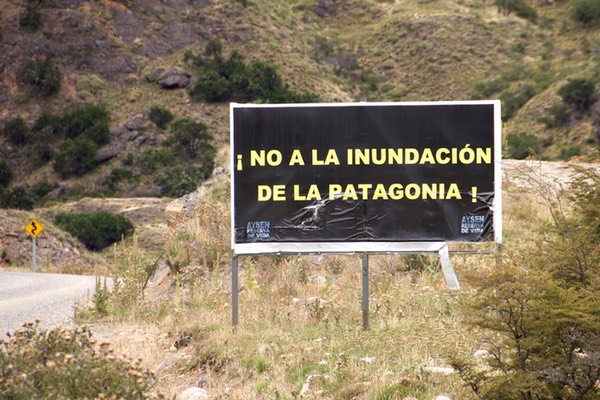
Again we were having a lovely day (our second in a row, to be commented upon!), and we took lots of pictures of the river with snow-capped mountains in the background. The trees were beginning to turn the yellows of fall, and the roses had finished blooming; they had produced the biggest rose hips I’ve ever seen. Quite a sight. We also took pictures of horses of a new and different kind. Very similar to our North American friends (which we have seen all over Central and South America), but stockier, with thicker necks and haunches (don’t you just love my technical discussion); friendly, they didn’t mind us preserving them for posterity. We suspect they are a European variety.
We meandered alongside the river, finally reaching Cochrane late in the day. The town was a bit of a disappointment, but no problem, we were having a good time. We noticed that the town was getting a bit of a facelift: the park was being redone, new sidewalks were being poured, etc. We had seen this same activity in other towns in the area, and there were several new bridges; seems the government is putting more money into southern Patagonia infrastructure. We tucked ourselves into a quiet spot for the night, noticing that we were being visited by mosquitoes (and dragonflies) for the first time in several months.
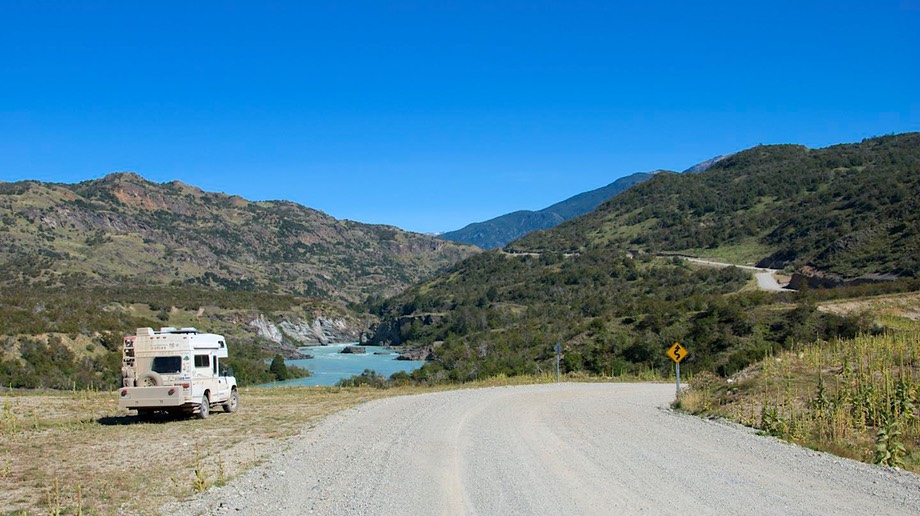
The next morning we briefly toyed with thoughts of going all the way to Villa O’Higgins, with stops at other highly recommended places in between. After all, there is something to be said for going all the way to the end of the road. Ultimately, the old adage of “never retrace your steps if you don’t have to” kept us from going further. We would miss some great scenery we knew, but there was lots more further north.
As it turned out, we made the right decision.
Retracing our steps, we again passed the turnoff to Chile Chico and Argentina, and began driving north. We planned to spend the night up the road a piece, along a secondary road that would take us out toward the Laguna San Rafael glacier. This road is supposed to be incredible all by itself, and would give us a chance to take a boat ride right out to the glacier. Totally cool.
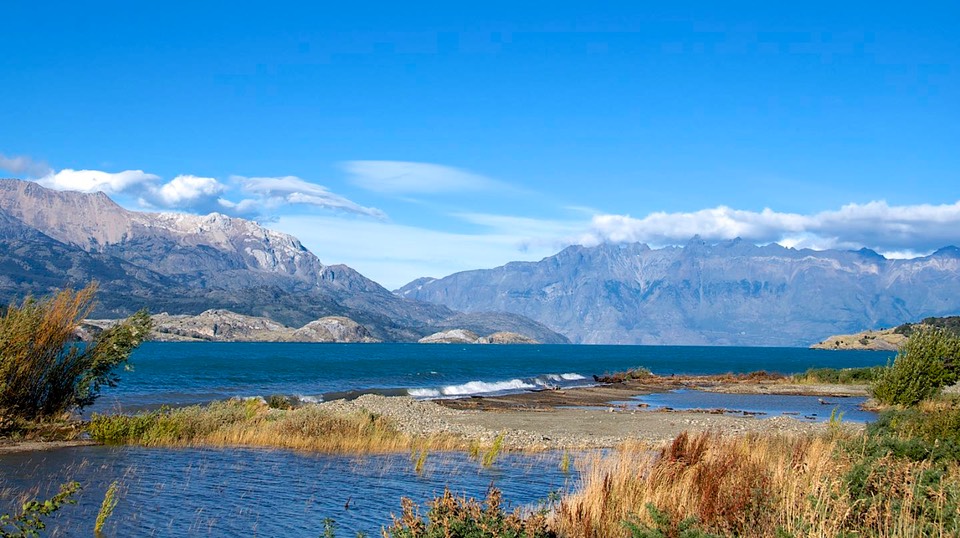
We never made it. A few miles on up Ruta 5 the truck engine started giving us major trouble. It said that it was overheating; we lost power; stopping and resting didn’t help. Rick quickly determined that the engine was not actually overheating so it seemed likely that we had an electrical malfunction that was sending the wrong signal to the dashboard electronics. Ultimately we managed to get to the top of an incline and then, fortunately, down a hill into the little town of Puerto Río Tranquilo. That was on a Thursday.
The town has two mechanics; they were unable to help. Rick and I looked at each other and muttered about how much worse this would have been had we decided to go further south than Cochrane.
We would end up stranded in this spot for four days while Rick went for help and various things were tried. On Friday Rick took the bus the 150 miles into Coyhaique, the biggest town in zillions of miles; on Saturday he returned with two mechanics from a garage up there. They drained the fuel and we put in fresh but that didn’t help. They took off, saying they would send a tow truck down for us.
He arrived mid-day on Sunday. René was a little guy (about 5’ 2”) with a big heart, and a tow truck that was almost big enough. He really tried. Finally giving up, he called the boss in Coyhaique to arrange for a bigger truck – which came in the middle of the night that night – two am to be exact.
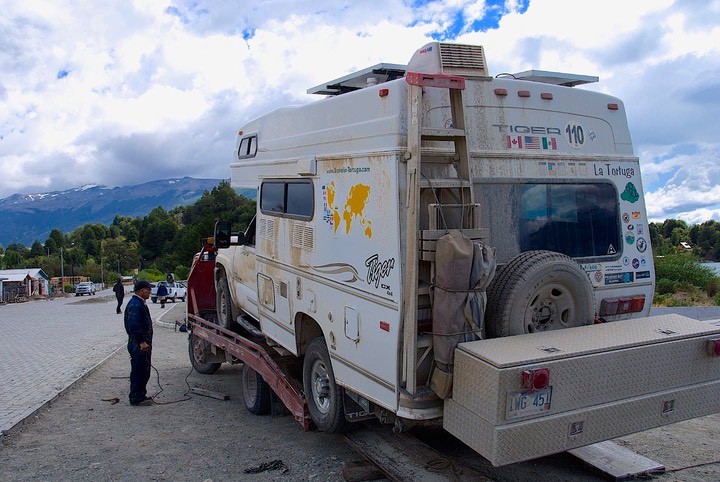
This truck was bigger and newer. Those guys loaded us up (after banging on the coach for awhile to wake us up), and then we spent 6 hours in the dark going the 150 miles up to Coyhaique (about two thirds of the way is still unpaved). Surely they could take care of us.
By the way, sitting in Puerto Río Tranquilo had been easy duty. It’s a lovely village on the edge of a lake with mountains across the way; a horse was grazing near us. We were parked just off the highway, and all the hitchhiking backpackers were gathered close to us, providing entertainment, conversation, and friendly advice. One fellow, an Israeli named Tom, reminded us that “it’s all in the game.” He was just great. We got to watch the town dogs (about 15 of them) chasing each other and the passing cars – they were too lazy to get very far, but having a good time with the pursuit. The townsfolk kept an eye on us, as did the local gendarmes. There were both a store and a panaderia; we were quite comfy.
To keep the story moving along, I’ll just say that we spent 4 days in Coyhaique, ultimately getting no where. They just didn’t have equipment that was sophisticated enough to deal with us although they could not have been nicer or more willing to help. The ultimate conclusion was that we needed to be in a real Chevrolet dealership, with real equipment, the closest one being up in Puerto Montt.
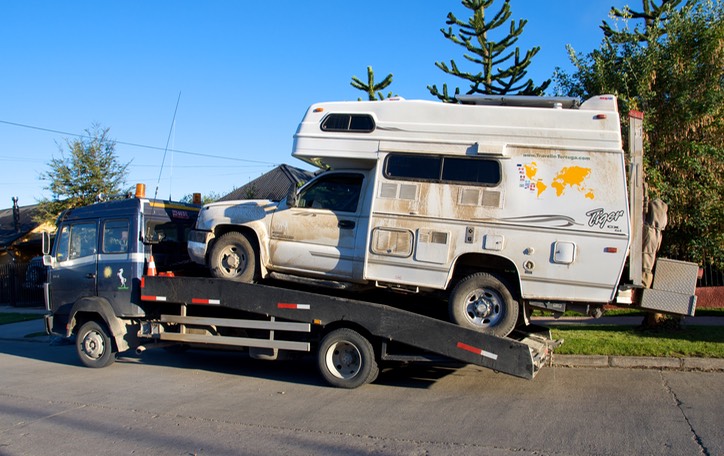
Now, remember: we can’t drive there; we can’t really drive much of anywhere. We can go short distances at a very slow speed; we have no power. The engine starts and runs, but has defaulted into a low power mode. We travel at a top speed of 12 mph; I’ve taken to waving like the Queen of England in a royal procession. Going up hills we drop to 5 mph. Nobody ever honks at us; they are amazingly polite; they just whip around and go on. In Coyhaique we stayed either inside the garage or parked next to it. We took taxis into the downtown area for groceries and wifi.
So… how do you get to Puerto Montt. You cannot drive, except by a long circuitous route through Argentina. If we were operating normally we could drive up further on Carretera Austral before taking a ferry from Chaitén, which had been our plan but not possible now. Or, you take the ferry from Puerto Chacabuco, roughly 50 miles from Coyhaique.
So back on a tow truck we went. The guy was slightly bigger than René, and his tow truck was a little bigger – but not much. We made it on, just barely; Rick was driving La Tortuga up the ramp, so he couldn’t see my face as the front wheels of the tow truck came off the ground about 4 inches. Wow!
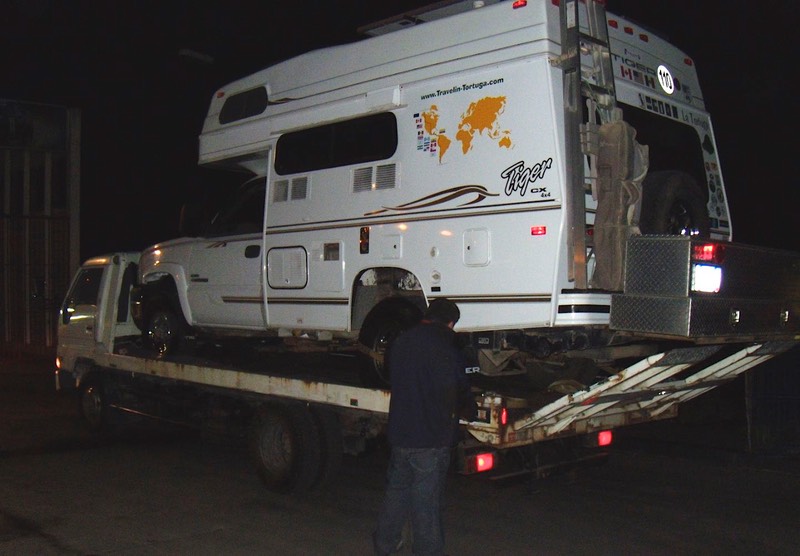
Pingüino (the truck driver – he was very short and stocky, and even referred to himself as a penguin) needed more fuel in order to both get to the port and back again, so we pulled into a gas station. No diesel. All out. And someone came up to us to say they’d heard the road to the port was closed between Aysén and Chacabuco because of a dock strike. The fuel plants are at the port; if that road is closed, no wonder everyone is running out of supplies.
We went to each fuel station in town; no diesel anywhere. But we were determined to try and make this work, as we understood the ferry only left once a week, and it was supposed to be loading at midnight. It was now 7:00 pm. So we convinced Pingüino to hit the road. He was delightful to us all the way there, not sharing any worries he might have had about his ability to get home again, or what might be in store. It started getting dark, but he kept pointing out the sights and telling us all about himself. He is a local Mapuche, one of the indigenous groups in this part of Patagonia. I wish I’d been able to take his picture; he was a true gentleman and amigo.
We got as far as Aysén, about 8 miles from the port, and the road was blocked - as advertised. Rocks were everywhere, and big fires had been set in tires placed in the middle of the road. Pingüino tried everything he could to find an alternate route to the port, but it was no go. Well, we had no choice. We couldn’t go back to Coyhaique; we would have to stay here until the strike was over. Someone said they thought maybe 3-4 days. There would be another ferry in another week. We’d be okay, if terribly frustrated. In the end, Pingüino off-loaded us at the local Copec fuel station, at our request. The station was all out of diesel at that point, but still had gasoline. We figured it would be a good place to stay, with water at hand and a small store as well. Also, we would certainly know when the strike was over, as the trucks would be pulling in there first. So he left us there, and drove off into the night. We never saw him again, and don’t know when he got back to his home in Coyhaique. I hope someone brought him enough diesel to get home and that he wasn’t stuck in Aysén for several days.
We were fine in Aysén. We could walk to the grocery store and internet. We called Navimag (the ferry boat people) and found that the next boat would be sailing on Tuesday (a break), and that they would transfer our reservation to the new day. We all hoped the strike would be over by then. We found out that it wasn’t actually a dock strike. The local artisanal fishermen were protesting a new cutback in their salmon limit. We suspect this is just the latest episode in the government squeezing them out of business in favor of the big guys; what else is new?
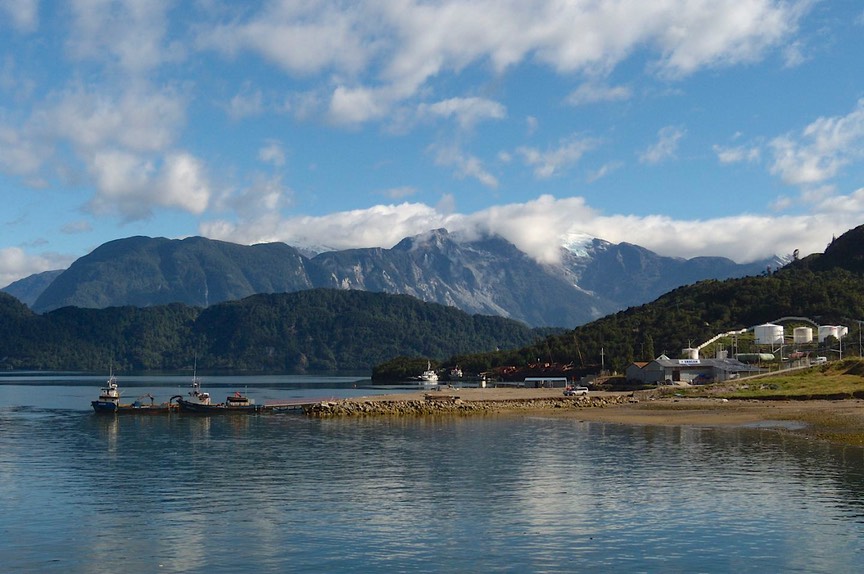
The town changed some as the days went by. By Friday there was no fuel of any kind for purchase in town. Soon we noticed that more people were walking, or riding bikes or even horses; everyone’s tanks were empty. The Copec station was very quiet, although they remained open, with full staff. People would come by to make a purchase from the little convenience store, or pump up their bicycle tires, or just to chat. They were very nice to us, seeming to welcome our presence. We felt cared for and secure. They knew we would be there until we could get on a ferry for Puerto Montt.
The grocery store in town was very busy the first day we were there; people were stocking up on supplies, making us wonder if we weren’t in for a very long wait. As the days went by, fewer people were shopping. Over the weekend we ran into an American who lived in town; it was he who filled us in on what was actually happening, and offered his home to us for anything we might need. A really nice fellow. His prognostication of the duration of the strike was quite gloomy; we hoped he was wrong. At night there would be noise from the area of the fires, and on Saturday evening there was a patrolling helicopter and more army troops than usual; we wondered how the negotiations were going.
On Sunday the usual town futbol game took place; nothing stops that! And then, Sunday evening, we saw Copec trucks pull up beside the station. The manager repositioned us to be out of the way, as the trucks were expecting to be able to get to the port that night, and would be returning later full of fuel. The strike was about to end.
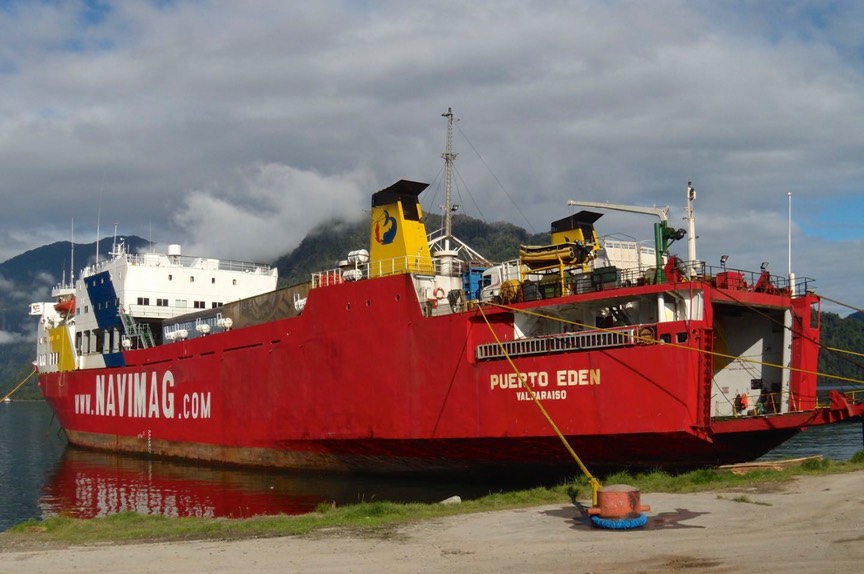
On Monday the station was abuzz; we were able to fill our tanks and slowly amble the few miles to Puerto Chacabuco, past still-smouldering fires and overturned vehicles beside the road. We managed to get aboard the ferryboat Tuesday, and Wednesday we arrived in Puerto Montt. Our journey was uneventful except that we met an American couple traveling in the area and spent some very pleasant time with them, exchanging stories and comparing notes on the good and bad in international travel. Nice folks.
Aside from the engine problems we were experiencing, the terrible downside of this adventure is that we totally missed an area we had been looking forward to visiting with a great deal of anticipation. The southern part of the Carretera Austral is stunning country, wild and undeveloped and gorgeous. We either didn’t see it at all, or only at night from inside a tow truck. It was a crushing disappointment.
But friends stood by us, and welcomed us to Puerto Montt. Our Australian buddies, Yasha & Jürgen, and Casper from Holland, were all at the dock to give us hugs. We had sent messages saying we should be arriving, and they had halted their journeys to hang around and wait for us. They already knew where the Chevy dealership was, and helped us get up the hill and settled, before we all went out for pizza. Good buddies; we were touched to say the least. A few days later our French friends Ann-Marie and Daniel, and their three children Pierre, Remí and Jeanne, all showed up to visit. Party time!
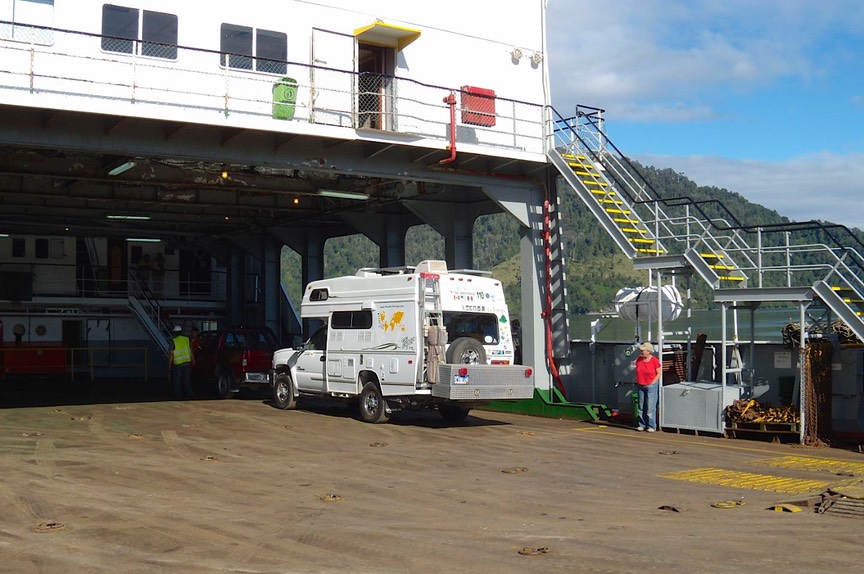
The next day we met with the Chevrolet folks and they began diagnosing the problems we were experiencing. Ultimately, a new engine computer was ordered from the United States, followed later by a fuel pressure sensor (which only had to come down from Santiago). The technicians seemed competent and professional. They had the needed tester and access to full diagnostic information on the computer even though our engine is not sold in South America – thank goodness for modern technology. The service manager, El Jefe de Servicio, was as kind and friendly as he could be. The language barrier was significant but not insurmountable, greatly helped by their ability to switch the GM diagnostic computer from Spanish to English in order to show Rick what was happening.
All in all things went as well as could be expected; if parts had been available on the shelf we could have been done in a couple of days. In the end, we were in Puerto Montt for 15 days, parked on a side street around the corner from the dealership. We got to know our neighbors; they were friendly and seemed quite aware of what was going on. We walked each day to one of a couple of places for internet access, we took a taxi to town one day for shopping and a movie. No one disturbed us. We even met a fellow looking at property for a business he was opening up, a Chilean with an American wife. He was delightful and very helpful.
We are now back on the road after four weeks. No need to share the frustrations further. We are staying in the area for a few days, and have ventured out onto the Chiloé peninsula to see the sights; we don’t want to get too far away from the dealership for a few more days. The tension is only now just beginning to go out of Rick’s shoulders, but so far so good.
It is definitely turning to fall. The poplars I mention from time to time are all turning bright yellow, the grasses are withering, and it’s raining more often. It’s time to start thinking of moving further north. On to new adventures!
From the road, and happy to be here…..
Rick and Kathy and a newly rejuvenated La Tortuga
PS: A wonderful French couple we met in Cusco last year recently had to ship their coach home as it had developed problems that could not be dealt with locally. Fortunately they were pretty much at the end of their time in South America, having been here for over two years. Anyway, after repairs were completed they said that the coach, named Jules, had “Rediscovered his youth”. We would say the same of La Tortuga.
Click the link to see more photos from Southern Chile.